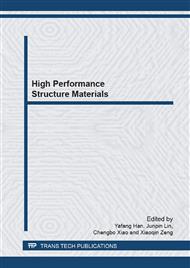[1]
Yuan GY, Zhang XB, Niu JL, et al. Research progress of new type of degradable biomedical magnesium alloys JDBM, J. The Chinese Journal of Nonferrous Metals. 21 (2011) 2476-2488.
Google Scholar
[2]
Sannakaisa Virtanen. Biodegradable Mg and Mg alloys: Corrosion and biocompatibility, J. Materials Science and Engineering B. 176 (2011) 1600-1608.
DOI: 10.1016/j.mseb.2011.05.028
Google Scholar
[3]
Gu XN, Zheng YF, Zhong SP, et al. Corrosion of, and cellular responses to Mg-Zn-Ca bulk metallic glasses, J. Biomaterials. 31 (2010) 1093-1103.
DOI: 10.1016/j.biomaterials.2009.11.015
Google Scholar
[4]
M. Alvarez-Lopez, Maria Dolores Pereda, J.A. del Valle, et al. Corrosion behavior of AZ31 magnesium alloy with different grain sizes in simulated biological fluids, J. Acta Biomaterialia. 6(2010) 1763-1771.
DOI: 10.1016/j.actbio.2009.04.041
Google Scholar
[5]
Wei Zhou, Tian Shen, Naing Naing Aung. Effect of heat treatment on corrosion behavior of magnesium alloy AZ91D in simulated body fluid, J. Corrosion Science. 52(2010) 1035-1041.
DOI: 10.1016/j.corsci.2009.11.030
Google Scholar
[6]
Zhang SX, Zhang XN, Zhao CL, et al. Research on an Mg-Zn alloy as a degradable biomaterial, J . Acta Biomaterials. 6(2010) 626-640.
Google Scholar
[7]
WITTE F, KAESE V, HaAFERKAMP H, et al. In vivo corrosion of four magnesium alloys and the associated bone response, J. Biomaterials. 26(2005)3557-3563.
DOI: 10.1016/j.biomaterials.2004.09.049
Google Scholar
[8]
HANZI AC, GUNDE P, SCHINHAMMER M, et al. On the biodegradation performance of an Mg-Y-RE alloy with various surface conditions in simulated body fluid,J. Acta Biomaterialia. 5(2009) 162-171.
DOI: 10.1016/j.actbio.2008.07.034
Google Scholar
[9]
Leeflang M.A., Dzwonczyk J.S., Zhou J. et al. Long-term biodegradation and associated hydrogen evolution of duplex-structure Mg-Li-Al-(RE) alloys and their mechanical properties, J. Materials Science and Engineering B. 176(2011)1741-1745.
DOI: 10.1016/j.mseb.2011.08.002
Google Scholar
[10]
Harpreet S. Brar, Joey Wong, Michele V. Manuel. Investigation of the mechanical and degradation properties of Mg-Sr and Mg-Zn-Sr alloys for use as potential biodegradable implant materials,J. Journal of the mechanical behavior of biomedical materials. 7( 2012) 87-95.
DOI: 10.1016/j.jmbbm.2011.07.018
Google Scholar
[11]
Erlin Zhang, Yang L. Microstructure, mechanical properties and bio-corrosion properties of Mg-Zn-Mn-Ca alloy for biomedical application, J. Materials Science and Engineering A. 497(2008) 111-118.
DOI: 10.1016/j.msea.2008.06.019
Google Scholar
[12]
M. Carboneras, M.C. García-Alonso, M.L. Escudero. Biodegradation kinetics of modified magnesium-based materials in cell culture medium,J. Corrosion Science. 53(2011)1433-1439.
DOI: 10.1016/j.corsci.2011.01.014
Google Scholar
[13]
Shahriar Koleini, Mohd Hasbullah, Hassan Jafari. Influence of hot rolling parameters on microstructure and biodegradability of Mg-1Ca alloy in simulated body fluid, J. Materials and Design 33(2012) 20-25.
DOI: 10.1016/j.matdes.2011.06.063
Google Scholar
[14]
Y. Xin, T. Hu, P.K. Chu. In vitro studies of biomedical magnesium alloys in a simulated physiological environment: A review, J. Acta Biomaterialia 7(2011)1452-1459.
DOI: 10.1016/j.actbio.2010.12.004
Google Scholar
[15]
Lei Yang, Erlin Zhang. Biocorrosion behavior of magnesium alloy in different simulated fluids for biomedical application,J. Materials Science and Engineering C. 29(2009)1691-1696.
DOI: 10.1016/j.msec.2009.01.014
Google Scholar
[16]
ANSI/AAMI. ISO 10993-5(1999). Biological evaluation of medical devices. Part 5[S].
DOI: 10.2345/9781570203848
Google Scholar


